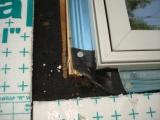Window Leaks

As you can see by the above photo, this new window was installed incorrectly. In addition to not being square and plumb in the frame, there is no flashing. Some contractors thing that flashing is only for roof penetrations. As home inspectors we know that any penetration or attachment for that matter should be flashed. That includes all windows, doors, and attached decks / porches. The problem with the window in the photo is that not only will it leak air; it will also leak water, and cause moisture and condensation to accumulate inside the house and on the plywood exterior sheeting. Eventually the wood members around the window will deteriorate and cause structural damage. If we are conducting an inspection before the siding is installed, we would be able to easily evaluate the lack of flashing and inform our client. But as we know, we are normally inspecting the house after the siding and drywall has been installed. So what are some of the things we can look for to help us determine if the windows were properly installed:
When viewing the windows form the outside carefully observe the sidewalls of the house. Any movement or bowing around window openings, especially large units, may indicate the structural members have deteriorated or weakened. All windows and doors should have drip caps installed on top. This metal flashing will ensure water does not get behind the siding. Any moisture stains, discoloration, cracks or lifted areas around windows on a stucco sided house indicate a water problem. If the house is sided with EIFS, look for areas that appear to be pulling away form the siding or moisture on the window itself.
Staining or discoloration of any siding may also indicate a lack of flashing. If a microbial substance is observed around the window unit or on the siding; further investigation is warranted.
On the interior of the house, of course moisture stains would be the first indication of a problem. If the house has EIFS siding, and the window is loose in the frame; that may indicate rotted structural members do to improper flashing or installation. Window units should not stick or bind when being operated. Check the lower areas of the sills for moisture stains. Look all around the window unit. Moisture may be present at the top, bottom or sides. If newer replacement windows have been installed, pay careful attention to all areas. I have seen air gaps on the top and sides of replacement window units. Remember calk is not a substitute for flashing. Just like the exterior; any microbial substance should be noted and further investigation should be recommended. Be sure to click the new products link for some information on new window and door flashing products.
Related Articles:
- Spray Foam Insulation – To Ventilate or Not
- Proper Air Sealing
- Proper Air Sealing & Moisture Control
- Forgotten Flashing
Want To Learn More? Click HERE to Search Our Full Database Of Home Inspector Newsletters.



